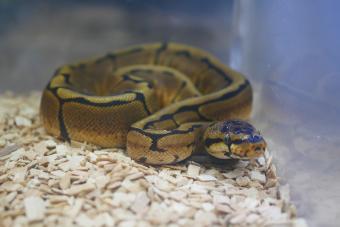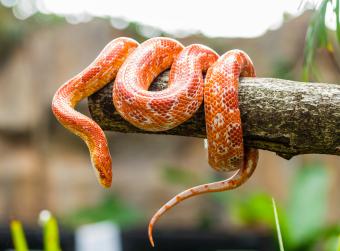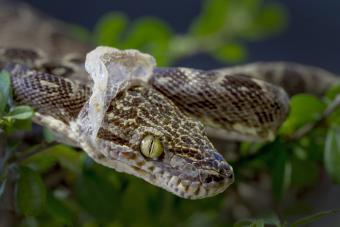
Keeping pythons as pets is easier than most people think. Find out why ball pythons are good pets for first-time snake owners and what you can expect when owning one.
Owning a Ball Python
Ball pythons, also known as royal pythons or Python regius, are in the same snake family as boas. All of these snakes are constrictors. Constrictor snakes wrap their body around their prey until the creature suffocates, then they swallow it whole.
How Big Do Ball Pythons Get?
Ball pythons are fairly small, and they typically reach only 36 to 48 inches long in adulthood, though females can grow to be 5 feet long. Pet stores that specialize in snakes will either have ball pythons on hand to purchase, or they may help you find a breeder.
How Long Do Ball Pythons Live in Captivity?
The ball python lifespan is about 30 years, although they've been known to live up to 40 or 50 years. How they're cared for will greatly affect their lifespan.
Benefits of Ball Python Snakes as Pets
Many people enjoy owning a ball python as their first pet snake because they are easy to handle. The more you handle and hold your ball python, the tamer they will become as they grow used to your touch. It is a good idea to bring your snake out once per day to interact.
Do Snakes Make Good Pets?
Other benefits of ball pythons as pets are:
- They require very little maintenance as compared to caring for a dog or a cat.
- They eat only once per week.
- They only defecate approximately once per week.
- Cage cleanup is fairly easy.
- Ball pythons are generally considered safe, even around young children, though always supervise handling when snakes are out of their enclosures.
- Ball pythons can live up to 50 years when cared for in captivity, so be aware of this potential commitment.
Caring for Your Pet Ball Python

Ball pythons are reasonably easy to care for. The following are some tips for setting up enclosures and taking care of ball pythons as pets.
Setting up the Cage
A 40-gallon glass aquarium makes a decent habitat for a snake. Make sure it has a secure lid with ventilation. Pet stores make screen lids specifically for reptile aquariums. Cover the bottom of the cage with a substrate such as newspaper, AstroTurf for reptiles, orchid bark, or moss. Some people like to use aspen or pine shavings for substrate, but these can both make the environment a bit too dry for your pet's comfort.
Supply the cage with:
- A water bowl
- A soaking tub
- A heat lamp or heat mat
- A thermometer
- A light
- A box to hide in
- An object to rub up against to remove skin
Feeding Your Ball Python
Ball pythons eat either mice or small rats. Usually, these meals are live, but sometimes you can train your ball python to eat a frozen (thawed-out) mouse. Whatever you decide to feed your snake when they are young is what they will continue to want to eat when they get older. If you prefer to feed your snake live rodents, start them out on that while they are young. Otherwise, choose thawed-out, frozen mice. Pet supply stores usually stock both types of rodents for snakes to eat.
The feeding process:
- Place the rodent in the cage or in another container you have chosen to use for feeding.
- Place the snake in the same cage.
- Place the lid back on the cage and wait until the snake senses their meal has been served.
- Stay and observe the eating process; if the snake is not hungry, the mouse or snake should be removed because the rodent can scratch or bite the snake.
- If the snake did not eat, try feeding them the next day.
Handling a Ball Python

Ball pythons are naturally shy, so you should allow your new pet to take some time to de-stress after you bring them to their new home. Give them a few days to feel comfortable in their new environment. A good sign that the snake is feeling relaxed is if you see them eating. Then you can begin the first steps in handling them.
- Once you've fed them for the first time, allow a few more days to pass. They will be digesting their meal during this time.
- If they won't eat, they may still be stressed and need more time to acclimate to the habitat. Make sure everything in the tank is set up for the most appropriate environment for your ball python and leave them alone for a few days and then see if they will eat.
- Don't attempt to handle them until they have eaten at least once. Wait at least a full 24 hours after their meal, because if you handle them too soon, they may regurgitate.
- Once they've eaten, plan on handling a young snake no more than once a week, and do so when you know they have digested their last meal completely. Mature snakes can be handled more often, but always after their digestion is done.
- Some "don'ts" when handling a ball python are to never grab them by their tail or lift them by the head.
- You can take them out of a tank using a hook and your hands to support them. You can also use just your hands, but always keep their body completely supported to keep them from becoming anxious and afraid, and to prevent injury.
- The first time you pick them up, lift around the middle area of their body and make sure you support their body. Don't grasp them tightly or restrict their movement, especially their head.
- Another "don't" is coming from behind and lifting them. Your snake may become defensive when startled, so allow them to see you coming first.
- You also should not pick them up when they are shedding.
- Make sure you wash your hands before and after handling your snake to prevent the spread of dangerous bacteria.
Ball Python Temperament
Ball pythons are often the first snake for a reptile lover because of their easy temperament. They are not known as biters unless they feel afraid, or if they decide they need to defend themselves. Generally, a ball python who is stressed will demonstrate where they get their name from. They roll their bodies into a ball and hide their heads as a defense mechanism.
Illnesses in Ball Pythons
Snakes, including ball pythons, are relatively disease-free, but they can carry Salmonella, which doesn't harm the snake but can be transferred to people. Just to be on the safe side, it is always a good idea to wash your hands after handling your snake. Ball pythons get a few diseases and ailments that you should be on the lookout for:
- Mouth rot - Also known as infectious stomatitis, this disease results from various types of infection and presents as small hemorrhages on the snake's gums, production of excessive mucus, or swelling around the snake's mouth, among other symptoms.
- Blister disease - This condition usually results from living conditions that are too humid, and symptoms include small blisters or orange dots on the snake's skin.
- Respiratory infection - This disease usually results from a viral, bacterial, or fungal infection, and may present with a host of symptoms, including mouth swelling, difficulty breathing, lethargy, and more.
- Mites - This parasitic infestation of snake mites, which are small, black or red arthropods that specifically feed on the blood of snakes (don't worry, you and your other pets can't catch them), can be life-threatening, so watch to see if you snake is soaking excessively (attempting to drown the mites) or appears agitated, and check your snake for mites.
- Ticks - Yes, ticks can feed on snakes, and they sometimes crawl underneath these reptiles' scales to access their blood. Check your snake if you see a lump wedged beneath a scale, and look closely, because ticks can sometimes blend in with your snake's natural coloration.
These illnesses can be treated with medication, so always take your pet to a veterinarian that specializes in snakes.
Choosing a Pet Ball Python Snake
Choosing a healthy snake is very important. Look for these qualities in a healthy snake:
- Well-rounded body
- Clean and clear eyes
- Breathes without wheezing
- No bubbles or liquid around nostrils
- Alert behavior
- Gently grips your arm or hand when held
Do Your Research
Ball pythons are amazing creatures, but snakes are not the right pet for everyone. Make sure you put in a good deal of time researching this snake and their needs, and spend time handling one to make sure this is the pet for you. Keep in mind that you'll be making a commitment to care for this pet throughout their lifetime, so make sure you're prepared to do so.







